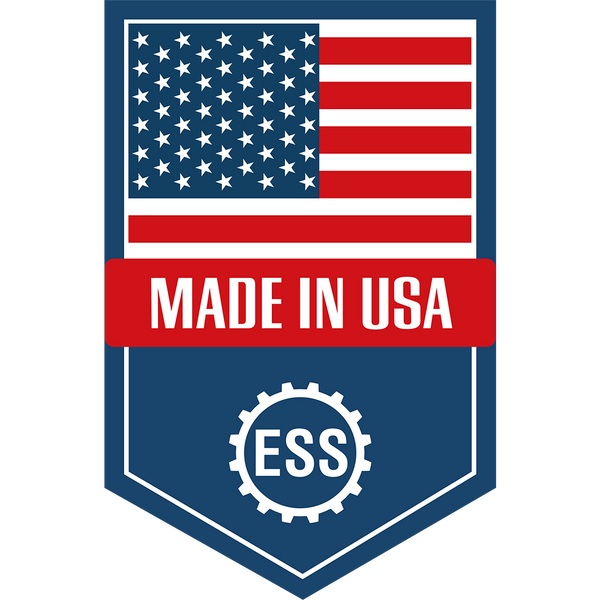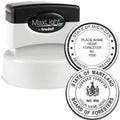Have you ever thought about how a simple logo stamp for packaging labels could make your products instantly more memorable? Small businesses often worry about costly printing options, but a custom stamp can offer a creative and affordable solution. By stamping your logo on every box, bag, or label, you deliver a personal touch that sticks with customers long after they open their packages. Let’s explore how you can create a logo stamp that does more than just mark your brand—it adds a dash of personality and makes you stand out in a crowded market.
Recognize the impact of custom stamping
When you’re running a small business, every impression counts. A well-designed stamp transforms standard packaging into an extension of your brand’s identity. It’s like handing your customer a tiny piece of your story each time they unwrap an order.
Why do logo stamps resonate so strongly? For one, they show attention to detail. Think about how satisfying it is to see a business’s unique mark on labels, tissue paper, or envelope seals. It sets the stage for an experience rather than just a transaction. People instantly sense you’ve gone the extra mile, and that’s something they remember.
Stamping can also be a springboard to word-of-mouth marketing. When folks see an interesting logo on the outside of a package, they’re more likely to ask questions, share photos, or talk about it with friends. In other words, your stamp can spark curiosity that leads to new connections—and potentially new customers.
Explore your stamp options
Before it’s time to load up on ink, get familiar with the different types of stamps on the market. Whether you prefer focusing on speed, detailing, or cost efficiency, there’s a stamp style suited to your needs.
Self-inking versus traditional
- Self-inking stamps come with built-in ink pads and deliver quick, consistent impressions. You press down, and the internal pad automatically re-inks your stamp each time. These are popular for busy operations where you need to label a large volume of items in less time.
- Traditional wood or acrylic handle stamps require a separate pad. You manually press the stamp onto the pad, then onto your packaging. While it takes a bit of practice to get fully even prints, these stamps often have a classic, artisanal charm that self-inking options can’t replicate. Some folks love the slight variations in each impression—it gives that handmade vibe.
Materials and durability
Stamps come in a variety of materials, and each material can impact both cost and quality. Here’s a quick table to help you compare:
| Stamp Material | Durability Level | Ideal Use Case | Price Range |
|---|---|---|---|
| Rubber | High | Frequent stamping, everyday business tasks | Moderate to High |
| Polymer (Plastic) | Medium | Occasional stamping, intricate logo designs | Entry to Moderate |
| Metal (Engraved) | Very High | Heavy-duty commercial or industrial purposes | Higher cost |
Rubber stamps typically stand up well to repeated use, and that’s why they’re a go-to choice for small business owners. Polymer stamps are thinner, which might be perfect for more detailed artwork if you’re okay with careful handling. Metal or engraved stamps, on the other hand, can handle intense environments like warehouse settings or shipping departments where stamping is constant.
Where to find custom solutions
Several online and local shops offer custom stamp-building tools. You simply upload your design, choose your size, and let the manufacturer handle the details. If you prefer a specialized partner, consider reaching out to Engineer Stamps (ESS). They’ve worked with countless small businesses worldwide to produce stamps that match specific branding needs. Their expertise means you can worry less about quality control and focus more on growing your business.
Design a captivating logo
A stamp is only as striking as the design you choose. Whether your logo is brand-new or something you’ve proudly displayed for years, it’s vital to adapt it for stamping so it remains crisp and eye-catching on different surfaces.
Simplify your elements
The first step is reducing busy or ultra-thin design features. Fine lines or intricate shading may get lost once stamped, resulting in a blurry and less-legible impression. Simplify any small text, thin lines, or complicated patterns. Bold outlines, strong shapes, and a balanced layout generally translate better onto packaging surfaces.
Opt for high contrast
Even if you’re going for a colorful flair, stamp inks are typically single-color. Think about how your logo’s most important details will stand out when only one color is used. If your official logo has multiple colors, consider a high-contrast black-and-white version. This approach makes your design more versatile and ensures that each stamped impression reads clearly from a distance. And hey, a monochrome version of your logo often looks pretty stylish.
Test before finalizing
You don’t want to order a batch of 500 stamps only to realize the impression doesn’t match your expectations. Start with a digital proof if possible. Once you have a rough sample, print it onto paper and see how it translates. If you can, order a single test stamp first. This small investment may save you time and money—plus frustration—down the road.
Select the right ink colors
While black ink is an obvious go-to, adding color can energize your brand and spark interest. Ask yourself: does your brand vibe with a soft pastel or a bold jewel tone? Here’s a quick overview of ink options to consider:
- Water-based inks: Dries quickly, easy to use, and fairly inexpensive. Perfect for paper-based packaging.
- Solvent-based inks: Adheres well to non-porous surfaces like metal, plastic, or glossy paper, but often takes a bit longer to dry.
- Pigment inks: Usually thicker, providing a vibrant and opaque layer of color. Great if your packaging material is darker and you want the design to pop.
Then there’s the question of shade. If your brand palette includes a signature hue—maybe you’re known for a bright teal or a warm terracotta—pick an ink color that stays true to that identity. Just remember that certain lighter tones can lose their impact if your packaging is a similar shade. Contrast is key.
Apply the logo with confidence
Getting a clean, crisp imprint isn’t challenging if you’ve practiced a little and prepped your workspace. Here’s how to approach the actual stamping process:
- Choose a flat surface: An uneven surface can cause patchy impressions or half-stamped images. Your best bet is a table or countertop with good lighting.
- Use consistent pressure: Practice pressing down evenly across the entire stamp. If your stamp is large, ensure that every corner makes contact to avoid partial prints.
- Mind your placement: Decide on the best spot for your logo. Are you placing it on a corner flap, in the center of a box, or across a label? Consistency can build brand familiarity, so think about a “signature spot” for your design.
- Allow drying time: Even quick-drying inks need a few seconds to set, especially on glossy or coated materials. Stack or handle your packages only after the ink dries completely. This step prevents smudging that could dilute your brand’s polished look.
Stamping multiple surfaces
Your brand might appear on mailers, tissue paper, cardboard boxes, or even paper bags. The stamping technique might differ a bit for each material:
- Tissue paper and thinner surfaces: Don’t press too hard, or you risk tearing. Light but firm pressure should do the trick.
- Corrugated cardboard: The ridges might require a little extra ink or repeated stamping to ensure full coverage.
- Plastic or glossy coatings: Give ample drying time, and use an ink designed for slick surfaces.
If you’re feeling uncertain, test stamp on a few spare pieces of each material. With a little practice, you’ll become a pro at adjusting your approach for various surfaces.
Take care of your stamp
Stamps aren’t disposable items. With proper care, they can last a long time and yield consistently sharp impressions. Even if you do hundreds of stamps a day, simple cleaning and storage steps can keep your imprint looking fresh.
Cleaning tips
- Wipe excess ink regularly: With self-inking stamps, the internal pad re-inks automatically, so occasional cleaning of the stamp face prevents buildup. For traditional stamps, gently blot any extra ink off the surface.
- Use mild solutions: Warm water with a small drop of gentle dish soap is usually enough. Avoid harsh chemicals that might break down the stamp material. Pat the stamp dry with a paper towel—don’t let it soak.
- Clean between color changes: Whenever you switch from black to red ink or any other hue, be sure to wash your stamp first. Otherwise, you’ll end up with murky or mixed tones that muddle your design.
Storing your stamp
Give your stamp a dedicated spot in your workspace. If you’re using a self-inking style, store it upright to keep the internal pad from drying out. For traditional stamps, let them air-dry thoroughly after cleaning, then keep them in a small container or drawer to ward off dust.
Grow your small business presence
It may seem like a minor detail, but a custom logo stamp can open doors for your small business that you might not expect. Customers appreciate the personal touch, and it keeps them thinking about you post-purchase. That simple moment of noticing your image on a package can nudge them to check out your social media pages, refer you to a friend, or even become a loyal repeat buyer themselves.
Branding with minimal investment
If you’re working with a tight budget, custom stamps offer a clever way to brand your packaging without the expense of full-on custom printing. By using stamps on envelopes, boxes, paper bags, tissue, or even subtler elements like thank-you notes, you continue to reinforce brand recognition. Over time, this brand recall can directly influence your sales growth. Adding your website or social handle below the logo is another subtle but effective way to encourage further engagement.
Experiment with other uses
Don’t stop at just your outer packaging. Stamps are versatile enough to be used on:
- Business cards: Stamp each card for a customized texture.
- Event swag: Put your design on coasters, napkins, or small gift bags for promotional flair.
- Store decor: If you have a physical location, stamp your bags, receipts, or even signs to maintain a consistent brand identity.
- Seasonal promotions: Spice up holiday or special event packaging with one-time seasonal stamps. Highlight a limited edition color or playful phrase that still incorporates your signature look.
Making your brand visible in unexpected places can spark curiosity. Potential customers usually like discovering creative flourishes that differ from standard retail experiences.
Share on social media
Once you’ve perfected your stamping technique, why not show it off a bit? Behind-the-scenes glimpses of how you prepare orders pique interest. Whether it’s an Instagram reel of you carefully stamping boxes or a TikTok video demonstrating your favorite packaging hack, people love seeing the hands-on effort that goes into their purchases.
Social media posts are also a fantastic way to connect with other small business owners. You might pick up tips from folks who use different stamping methods, or you could form collaborations that introduce your brand to new audiences. The possibilities only expand with a little creativity and community spirit.
Wrap up
A custom logo stamp isn’t just a practical tool—it’s a vehicle for storytelling. When you stamp your brand onto a box, you’re delivering more than a product, you’re sending a piece of your identity directly into your customer’s hands. It’s personal, it’s unique, and it’s something they can remember the next time they’re deciding where to shop.
Whether you’re using a self-inking style for speedy labeling or a traditional wooden handle for an artisanal look, the key is consistency and care. Start by selecting a design that’s easy to read, choose the right ink for your materials, and practice until each impression is crisp and clean. You might be pleasantly surprised at how one simple square of rubber (or polymer) can broadcast so much about your brand. If you’re looking for support along the way, feel free to check out Engineer Stamps (ESS), where you’ll find stamp options for all kinds of business goals.
Ready to take that first step toward more cohesive branding? Grab a test stamp, roll out some packaging materials, and see how a thoughtfully placed logo can transform plain boxes into powerful marketing assets.
FAQs
Do I need a specific file format for my logo design?
Most stamp makers will require a high-resolution image, ideally in a vector format like .AI, .PDF, or .EPS. If you’re not sure, check with your preferred vendor to see which file types they can handle.Can I include text alongside my logo on the stamp?
Absolutely. Many businesses add a short slogan, website URL, or social handle below their logo. Just be sure to keep any text large and bold enough for comfortable reading once stamped.Does using colored ink require special care?
Colored inks might need a bit more shaking or stirring before use. Also, always clean the stamp thoroughly before switching shades, especially if you want an even, consistent hue each time.How many impressions can I get before re-inking?
It depends on the type of stamp and the size of your ink pad. With self-inking stamps, you can typically get several thousand impressions before needing to replace or re-ink the pad. Traditional stamps might need frequent ink application, but overall it’s still cost-effective and easy to manage.Is there a recommended size for my logo stamp?
The size depends on where you plan to stamp. For shipping boxes, a bolder, larger stamp is more visible. For smaller tags or labels, you’ll want something more compact. Measure your typical stamping areas to find the best fit.How do I deal with smudges or uneven impressions?
Smudges happen if you’re pressing too hard or not giving the ink time to dry. Uneven impressions often come from an angled press or an uneven surface. Practice makes perfect—stamp a few test scraps and adjust your pressure and angle until the design looks crisp and clean.
Your logo stamp can power more memorable experiences for your customers. Start small, refine your technique, and watch how a little ink adds dialogue between you and the folks who support what you do.


















